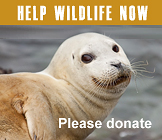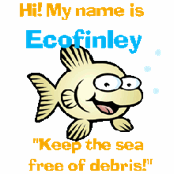Spanky
Seal season off to a rough start in West Seattle
Sep/21/14 06:19 PM
Each harbor seal pupping season (late June - September in South Puget Sound) seems to have its own unique properties. We hate to say it, but this 2014 season is off to a bleak start in West Seattle.
Some years, Seal Sitters MMSN (SSMMSN) responds to lots of pups who show up only for a day or so. Other years, we’ll have a number of pups, successfully making the transition from nursing on mom’s rich milk to foraging on their own, who come ashore for many days in a row (like Spanky and Queen Latifah, both of whom hauled out every day for two months) - the years we seemed to have a surplus of small forage fish in the Fall.
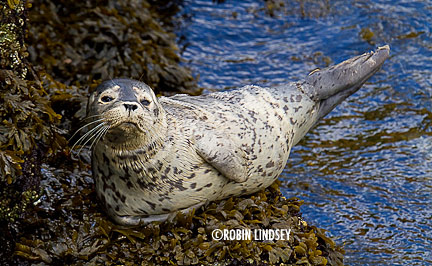 Most years, we have a mix of some healthy pups (like Queen Latifah at left on her rocky throne in 2011) to offset the many struggling ones. The last few years, however, we have had way too many terribly thin pups who didn’t survive. So, the stranding network never knows quite what to expect.
Most years, we have a mix of some healthy pups (like Queen Latifah at left on her rocky throne in 2011) to offset the many struggling ones. The last few years, however, we have had way too many terribly thin pups who didn’t survive. So, the stranding network never knows quite what to expect.
The 2014 season so far has had its quirks, too. For the first time in our 8 years as a stranding network, in early June we had a full lanugo, month-premature pup, believed to have been born on busy Alki Beach. Nicknamed Luigi, he was the earliest newborn pup on record for West Seattle. Sadly, the tiny, abandoned pup had to be euthanized. Another abandoned, but full-term pup was rescued by Seal Sitters from the craggy rocks at Duwamish Head at the end of June. This pup, Junebug, was successfully rehabbed at PAWS Wildlife Center and released back to the wild on August 26th.
To date, Junebug is the only highlight in what is shaping up to be a very disheartening season. Statistically, seal pupping season in West Seattle is recorded from our first response to a newborn pup in the calendar year (usually in mid-late July or August) through the end of the year as pups continue to use the shoreline. We have had fewer responses than our record-breaking season last year, but already have a higher dead pup count in this recent period from the lanugo pup in early June through September 20th. A full third of our responses this season have been to dead pups or pups that subsequently died.
Disturbingly, we have had three pups die in recent weeks with numerous bite wounds to the head and body. Are the seal pups getting roughed up before leaving the rookeries by adult males, intent on mating and competing for space - or are they being attacked on our shores by off-leash dogs or coyotes? That is a question we most likely cannot answer with limited funding for necropsies.
While there is indeed a 50% mortality in the wild for seal pups the first year, the percentage of Seal Sitters MMSN’s responses to dead seal pups just seems to be higher the past few years. We want to be clear that our numbers do not necessarily reflect Puget Sound populations as a whole and the harbor seal population is considered healthy and is not endangered. Other areas may have a more plentiful food source and more successful pups.
We did have high hopes for a bumper crop of healthy pups visiting West Seattle this year, based on reports from biologists observing moms and pups at South Puget Sound rookeries. Apparently, there was less predation, pup abandonment and death this season at one historic harbor seal haulout. As of last week at that island rookery south of Tacoma, only 24 pups (2 of those still nursing) remained - the other chubby 100 or so newly weaned pups had already dispersed, headed elsewhere to forage and rest. Perhaps some of those pups will head our way, evening out responses to emaciated ones.
As we mention over and over in these posts, harbor seal pups are in a daily struggle to survive - and health can take a dramatic downturn in just a matter of days. Undisrupted rest can truly make the difference between life and death. With the approaching wet chill of fall and winter months, seal pups face many challenges ahead of them. While Seal Sitters volunteers can’t control the effects of pollution, disease or declining fish stocks (including that of two sustaining forage fish for seal and sea lion pups: Pacific herring and sardines), what we can do is help pups rest and warm up, giving them a better chance at survival. Additionally, we can spread some powerful education about these amazing animals who share equal time in the sea and on land.
Despite the emotional ups and downs for volunteers, Seal Sitters MMSN will always do our best to ensure that seal pups are protected - free from stress - while resting on our shores. You can help. Please, call our dedicated hotline at 206-905-SEAL (7325) if you see a marine mammal, dead or alive, on public or private beach.
Some years, Seal Sitters MMSN (SSMMSN) responds to lots of pups who show up only for a day or so. Other years, we’ll have a number of pups, successfully making the transition from nursing on mom’s rich milk to foraging on their own, who come ashore for many days in a row (like Spanky and Queen Latifah, both of whom hauled out every day for two months) - the years we seemed to have a surplus of small forage fish in the Fall.

The 2014 season so far has had its quirks, too. For the first time in our 8 years as a stranding network, in early June we had a full lanugo, month-premature pup, believed to have been born on busy Alki Beach. Nicknamed Luigi, he was the earliest newborn pup on record for West Seattle. Sadly, the tiny, abandoned pup had to be euthanized. Another abandoned, but full-term pup was rescued by Seal Sitters from the craggy rocks at Duwamish Head at the end of June. This pup, Junebug, was successfully rehabbed at PAWS Wildlife Center and released back to the wild on August 26th.
To date, Junebug is the only highlight in what is shaping up to be a very disheartening season. Statistically, seal pupping season in West Seattle is recorded from our first response to a newborn pup in the calendar year (usually in mid-late July or August) through the end of the year as pups continue to use the shoreline. We have had fewer responses than our record-breaking season last year, but already have a higher dead pup count in this recent period from the lanugo pup in early June through September 20th. A full third of our responses this season have been to dead pups or pups that subsequently died.
Disturbingly, we have had three pups die in recent weeks with numerous bite wounds to the head and body. Are the seal pups getting roughed up before leaving the rookeries by adult males, intent on mating and competing for space - or are they being attacked on our shores by off-leash dogs or coyotes? That is a question we most likely cannot answer with limited funding for necropsies.
While there is indeed a 50% mortality in the wild for seal pups the first year, the percentage of Seal Sitters MMSN’s responses to dead seal pups just seems to be higher the past few years. We want to be clear that our numbers do not necessarily reflect Puget Sound populations as a whole and the harbor seal population is considered healthy and is not endangered. Other areas may have a more plentiful food source and more successful pups.
We did have high hopes for a bumper crop of healthy pups visiting West Seattle this year, based on reports from biologists observing moms and pups at South Puget Sound rookeries. Apparently, there was less predation, pup abandonment and death this season at one historic harbor seal haulout. As of last week at that island rookery south of Tacoma, only 24 pups (2 of those still nursing) remained - the other chubby 100 or so newly weaned pups had already dispersed, headed elsewhere to forage and rest. Perhaps some of those pups will head our way, evening out responses to emaciated ones.
As we mention over and over in these posts, harbor seal pups are in a daily struggle to survive - and health can take a dramatic downturn in just a matter of days. Undisrupted rest can truly make the difference between life and death. With the approaching wet chill of fall and winter months, seal pups face many challenges ahead of them. While Seal Sitters volunteers can’t control the effects of pollution, disease or declining fish stocks (including that of two sustaining forage fish for seal and sea lion pups: Pacific herring and sardines), what we can do is help pups rest and warm up, giving them a better chance at survival. Additionally, we can spread some powerful education about these amazing animals who share equal time in the sea and on land.
Despite the emotional ups and downs for volunteers, Seal Sitters MMSN will always do our best to ensure that seal pups are protected - free from stress - while resting on our shores. You can help. Please, call our dedicated hotline at 206-905-SEAL (7325) if you see a marine mammal, dead or alive, on public or private beach.
Weather cools down, but seal pup activity heats up
Oct/17/13 07:25 PM
Just as fall weather has turned very brisk, so has the number of seal pup responses along West Seattle’s shoreline. There has been a noticeable increase in activity the past week or so. According to Seal Sitters volunteer Richard, an avid diver, he has been seeing more bait balls of the small forage fish that are indispensable to the marine ecosystem and a favorite food of seal pups (read more about forage fish here). Last evening until just after dark, Richard and fellow volunteer Suzanne looked over new pup Humphrey who snoozed below Beach Drive. A very tiny pup, Humphrey could stand to snack on some of those fish and pack on some blubber to keep him warm in Puget Sound’s frigid waters. He returned to the water sometime overnight.
Seal pup Tiger continues his/her routine of hauling out just around dark every evening on the Elliott Bay side of West Seattle. He is thriving and it is a joy for volunteers to see such a seemingly healthy, vigorous pup. Tiger does seal pup yoga on the smooth beach sand, stretching his tail high and curving his body into a “u” shape - the classic “banana pose”. This behavior is his way of circulating warmth - or thermoregulating his temperature.
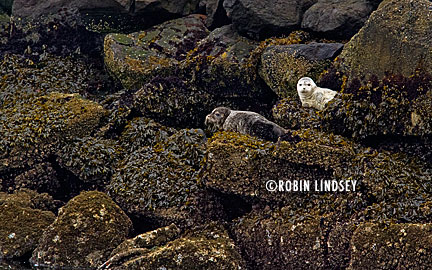 On a somewhat unusual note, for the past two days (possibly more that we were unaware of) pups have been hanging out together on the rocks along one of the sea walls. These young harbor seals come in at high tide during the night and are left quite vulnerable resting on the jagged rocks far above the water level, where they wait for the tide to return.
On a somewhat unusual note, for the past two days (possibly more that we were unaware of) pups have been hanging out together on the rocks along one of the sea walls. These young harbor seals come in at high tide during the night and are left quite vulnerable resting on the jagged rocks far above the water level, where they wait for the tide to return.
Each morning, responders have taped off the area above them so that they can rest undisturbed and not be at risk for fall and potential injury. Despite this, on Tuesday morning a woman went under the tape clearly marked with a “Do Not Enter” sign, standing a few yards from the pups and refused to leave, asking what harm she was doing. We tried to explain to her that there was a very real danger to these pups if they were scared and tumbled down 15 feet of craggy rocks with deep holes (seal pups Henry and Spanky fell deep into holes in past seasons).This is, of course, beside the fact that going under the tape and disturbing a maine mammal is breaking a federal law, the Marine Mammal Protection Act (read more here). It was quite sad that this woman created a contentious scene over our efforts to give these pups some rest. The pups could easily be seen from a sidewalk viewpoint and the posted signs explained that seal pups need undisrupted, stress-free rest to survive against challenging odds - a 50% mortality. People standing too close is most definitely a source of stress, which has been proven in many studies to negatively impact health in humans and animals. Thankfully, unpleasant incidents are rare. Most people are thrilled and empowered to be able to help a pup survive by simply giving them space.
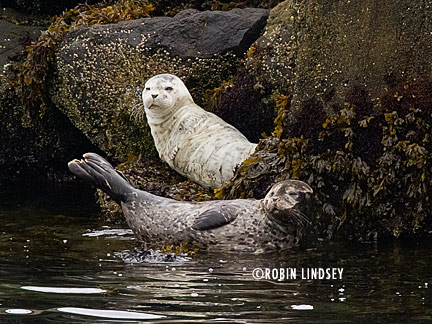 Volunteers set up a viewing scope so that the public could get an exceptionally close view of the pups, one with a beautiful light coat and the other with luxurious dark fur. It was a fantastic opportunity for passersby to learn about seal pup biology and behavior. The two pups returned to Elliott Bay mid-afternoon Tuesday when the tide finally reached them (photo right). The body weight of these two weaner pups seems to reflect that there is indeed more of a food source out there and we’ve observed quite a few pups fishing offshore. Most often, a pup will haul out close to where he is foraging.
Volunteers set up a viewing scope so that the public could get an exceptionally close view of the pups, one with a beautiful light coat and the other with luxurious dark fur. It was a fantastic opportunity for passersby to learn about seal pup biology and behavior. The two pups returned to Elliott Bay mid-afternoon Tuesday when the tide finally reached them (photo right). The body weight of these two weaner pups seems to reflect that there is indeed more of a food source out there and we’ve observed quite a few pups fishing offshore. Most often, a pup will haul out close to where he is foraging.
Yesterday morning before dawn, two light-coated pups were resting in almost the same spot. Unfortunately, as daylight increased, so did their nerves. The first jittery pup scooted back down the rocks to get to the water, tumbling the last few feet before landing in the bay with a big splash. This prompted the other pup to follow suit, disappearing in a watery splat.
These pups, only 2-3 months old, are now on their own with no adult to protect them. There is certainly safety in numbers for newly weaned pups; while one catches a snooze the other can be on the alert, providing a more satisfying rest. In all, Seal Sitters responded to 4 pups in West Seattle yesterday, with 3 the day before. We are comparing distinct markings to determine if the pups on the rocks are new visitors to our shores and will update Blubberblog with our findings.
Seal pup Tiger continues his/her routine of hauling out just around dark every evening on the Elliott Bay side of West Seattle. He is thriving and it is a joy for volunteers to see such a seemingly healthy, vigorous pup. Tiger does seal pup yoga on the smooth beach sand, stretching his tail high and curving his body into a “u” shape - the classic “banana pose”. This behavior is his way of circulating warmth - or thermoregulating his temperature.

Each morning, responders have taped off the area above them so that they can rest undisturbed and not be at risk for fall and potential injury. Despite this, on Tuesday morning a woman went under the tape clearly marked with a “Do Not Enter” sign, standing a few yards from the pups and refused to leave, asking what harm she was doing. We tried to explain to her that there was a very real danger to these pups if they were scared and tumbled down 15 feet of craggy rocks with deep holes (seal pups Henry and Spanky fell deep into holes in past seasons).This is, of course, beside the fact that going under the tape and disturbing a maine mammal is breaking a federal law, the Marine Mammal Protection Act (read more here). It was quite sad that this woman created a contentious scene over our efforts to give these pups some rest. The pups could easily be seen from a sidewalk viewpoint and the posted signs explained that seal pups need undisrupted, stress-free rest to survive against challenging odds - a 50% mortality. People standing too close is most definitely a source of stress, which has been proven in many studies to negatively impact health in humans and animals. Thankfully, unpleasant incidents are rare. Most people are thrilled and empowered to be able to help a pup survive by simply giving them space.

Yesterday morning before dawn, two light-coated pups were resting in almost the same spot. Unfortunately, as daylight increased, so did their nerves. The first jittery pup scooted back down the rocks to get to the water, tumbling the last few feet before landing in the bay with a big splash. This prompted the other pup to follow suit, disappearing in a watery splat.
These pups, only 2-3 months old, are now on their own with no adult to protect them. There is certainly safety in numbers for newly weaned pups; while one catches a snooze the other can be on the alert, providing a more satisfying rest. In all, Seal Sitters responded to 4 pups in West Seattle yesterday, with 3 the day before. We are comparing distinct markings to determine if the pups on the rocks are new visitors to our shores and will update Blubberblog with our findings.
Spanky and friends still using the shore
Dec/12/11 08:18 AM
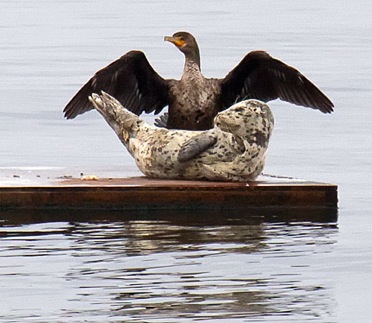
Volunteers also responded to two pups at Lincoln Park this past week. As long as there is a food source to support the now-weaned pups, they will continue to seek rest on shore. Please stay alert as you walk the beaches of Puget Sound and make sure to give us a call if you come across a seal pup or other marine mammal.
Craggy rocks spell trouble again for Spanky
Dec/03/11 10:42 AM
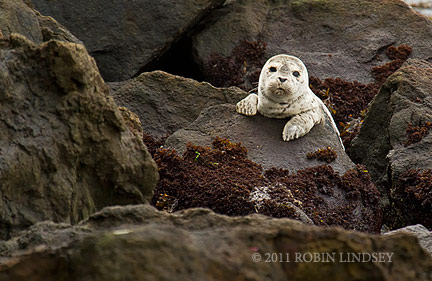
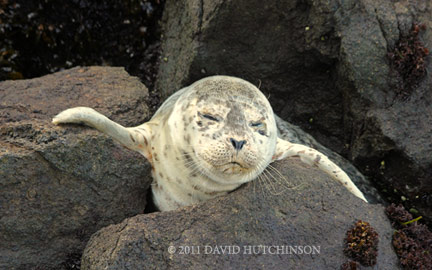
We want to remind the public that only certain authorized personnel from the NW Marine Mammal Stranding Network are allowed to handle a seal pup. It is a violation of the Marine Mammal Protection Act to touch, feed, move or otherwise disturb a seal. It can also be a dangerous endeavor as these are wild animals capable of inflicting a serious bite. If you see Spanky along the sea wall, please remember to keep your distance for his safety and call Seal Sitters. This little one seems to have a penchant for trouble and we want to keep him safe and healthy.
Spanky's thankful for rest
Nov/26/11 08:41 PM
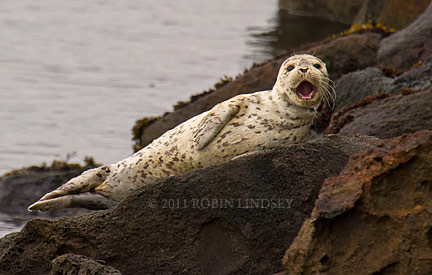
We hope our volunteers and readers had a wonderful holiday. Please know how thankful we are (and Spanky and his gang, too) for your support.
No end in sight for West Seattle volunteers
Nov/15/11 08:38 PM
West Seattle’s crazy seal pup season continues full bore. Today we had 4 pups in different locations. This morning at 5:30 our responder found a pup in a perilous location. Thankfully, the pup returned to Elliott Bay about 7:30 am. We were on the alert since he had hauled out in the same location last night. We are pretty certain the pup was Umbreon, looking very chubby and alert. About 10 am we located Spanky at his usual haulout and taped off the area around him. Even before we could get that perimeter established, the hotline received a call about a pup at Lincoln Park. One of our stalwart volunteers headed for the Park, found the thin pup and began stretching yellow tape between pieces of driftwood and stakes. The pup snoozed til the end of the day. Seal Sitters also investigated a report of a pup on the rocks below Salty’s restaurant. We have yet to identify this pup who returned to Elliott Bay about 4:30 this afternoon after resting since early this morning. Finally, Umbreon hauled out again about 6pm, returning to forage about 8 pm.
What does this all mean? People are surprised that we still have pups hauling out, since “pupping season” is officially over in our area. However, weaned pups continue to need shoreline habitat to rest (as they will their entire lifetime) and they will come ashore near where they forage. It seems apparent that West Seattle has a pretty good food source of late to support a number pups. And it certainly helps that they have found refuge in a location where volunteers respond quickly to help them warm up, doze and recharge undisturbed.
Last year, seal pup Queen Latifah was still hauling out with regularity til late December. Seal Sitters is in the throes of a record breaking year for seal pups. So, volunteers, please keep using the calendar to sign up for shifts - we need your help!
What does this all mean? People are surprised that we still have pups hauling out, since “pupping season” is officially over in our area. However, weaned pups continue to need shoreline habitat to rest (as they will their entire lifetime) and they will come ashore near where they forage. It seems apparent that West Seattle has a pretty good food source of late to support a number pups. And it certainly helps that they have found refuge in a location where volunteers respond quickly to help them warm up, doze and recharge undisturbed.
Last year, seal pup Queen Latifah was still hauling out with regularity til late December. Seal Sitters is in the throes of a record breaking year for seal pups. So, volunteers, please keep using the calendar to sign up for shifts - we need your help!
Spanky's back in town
Nov/12/11 05:18 PM
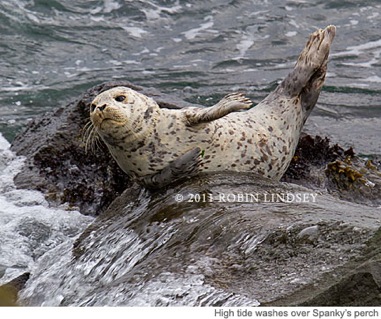
A surprising number of people were out jogging and walking, apparently trying to get their exercise in before the impending rainstorm. Soon thereafter, a cold rain began falling as volunteers arrived to do their “seal sitting” shifts and talk to passersby. We received a number of very nice comments today, thanking us for doing the work we do. That encouragement is always so appreciated, especially when dedicated volunteers are standing out in dreary and challenging weather conditions. We were concerned that we had not seen Spanky since last Friday. He fell deep into an inaccessible hole late Thursday afternoon (where he spent the night), but was rescued about noon the following day, examined for injuries and returned to the Sound. Needless to say, volunteers were thrilled to see him - even swirling winds and bitter rain could not dampen our spirits today. We often joke among ourselves that there should be a 12-step rehab program for volunteers hopelessly addicted to seal pups. Then we just shrug and laugh because the truth is, none of us want to be cured! Spanky returned to the water late in the afternoon at high tide. Thanks to everyone who watched over him.
Seal superhero rescues Spanky
Nov/04/11 06:22 PM
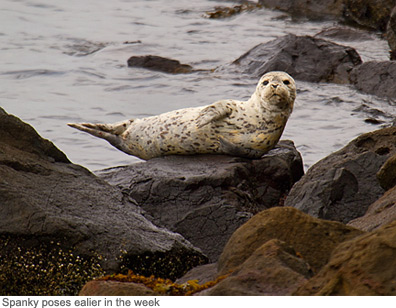
We turned to WDFW Marine Mammal Investigations’ biologist Dyanna Lambourn for her usual sage advice. She thought perhaps with a snare we could loop his back flippers and pull him up. So, that was the game plan put into action for this morning. Having spent a long and stressful night, Spanky was still trapped inside the hole at 6am, but was alert - a good sign. Read More...
Wiser pups choose safer haulouts
Nov/01/11 07:49 PM
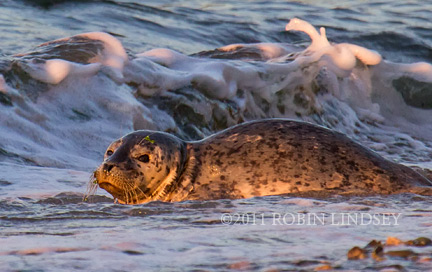
New pup Joy spent Friday in the rain on a private beach south of Alki, while another pup slept safely on a platform offshore. Homeowners kept a watchful eye on the pup until she returned to the Sound late in the afternoon. We have responded to reports of two additional pups hauling out on private beaches stretching as far south as Brace Point, where many homeowners have voiced concerns about off leash dogs.
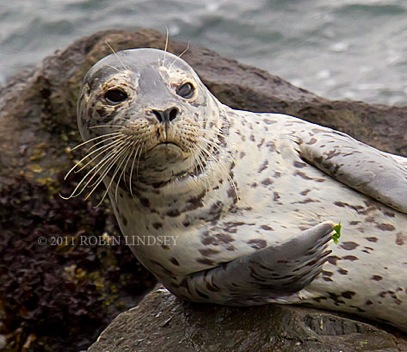
Off leash dog scares Abe at Lincoln Park
Oct/23/11 07:19 PM
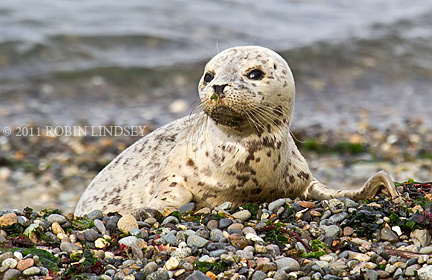
We plead with people over and over to please keep dogs leashed near the beach and to respect the city ordinance that dogs are not allowed on any public beach. A dog’s sense of smell is amazing - and one can just never predict how a dog will react when they discover a seal is on the beach. This is a good example of how a dog owner can overestimate the control they have over their pet and underestimate the pet’s reaction in these situations. The dog owner was apologetic. We were very lucky today that this seal pup was not seriously mauled or killed. Had Abe been ill or trying to heal from an injury, he would not have been able to escape. Abe did not return to shore.
Seal pup Spanky visited his favorite rock again today, but returned to Puget Sound at high tide.
Seal Sitters get a respite today after dawn to dusk days
Oct/20/11 11:01 PM
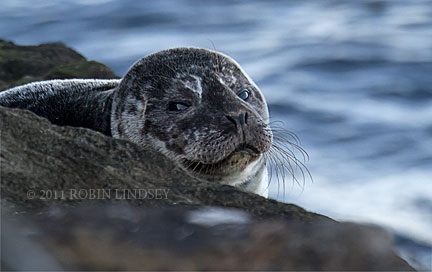
Sly, who had been looking too thin and spending more and more hours on shore, finally returned to Elliott Bay early Tuesday morning. Since that time, he has not been observed on his favorite haulout rock. We’re hoping that his many hours of rest has given him the strength to forage and pack on some desperately needed pounds. A small white pup who could be Sly has been observed along with several other pups fishing and lingering in the waters nearby. As pups are weaned and become thinner, their immune system is suppressed, making them vulnerable to parasites and viruses. Small fish seem to be plentiful now around West Seattle and Sly could use a second trip through the buffet line.
We have two additional newcomers: Noche who spent the evening on the south end of Alki Beach Sunday (our fourth pup onshore that day) and Abe who came ashore at Lincoln Park on Tuesday. This is one crazy pup season we are having this year - and the volunteers are loving it!
Pup-ulation explosion on shores of West Seattle
Oct/06/11 08:17 PM
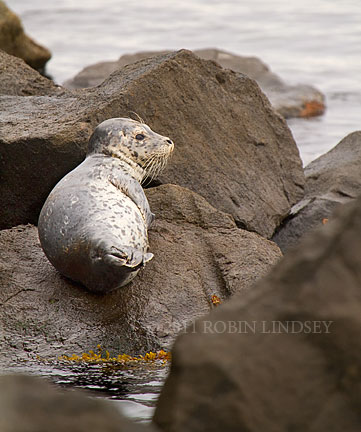
This year, from August - October 5th (yesterday), we have already surpassed last year’s five-month total: 35 different pups have now been observed and protected by our West Seattle volunteers! And October is typically one of our busiest months, so we can only guess how many pups we’ll have by the end of the year.
Our 35th pup is shown in the photo here. Nicknamed Spanky, this very robust and alert pup found a nice rock to rest upon before the incoming tide’s waves sent him swimming off into the Sound. This is just the kind of round pup with a thick blubber layer that we want to see this time of year, when too many are becoming thinner and trying to survive. Blacky, who has been using Lincoln Park for several weeks now, has become noticeably thinner the past two sightings. Seal pup Aquarius, who hauled out at Constellation Park for two days in a row, was rescued from that beach Friday, but died at PAWS. We cannot stress enough that seal pups need to rest and warm up undisturbed in order to maintain their strength and keep their immune system resilient.

